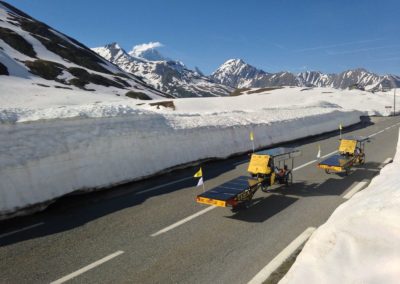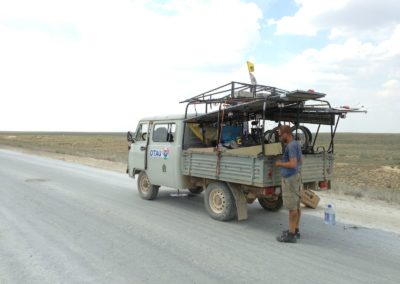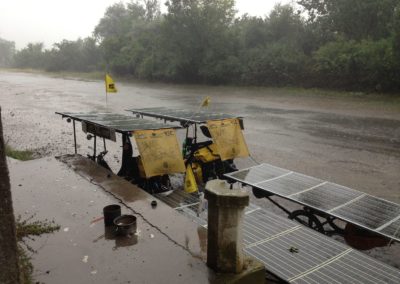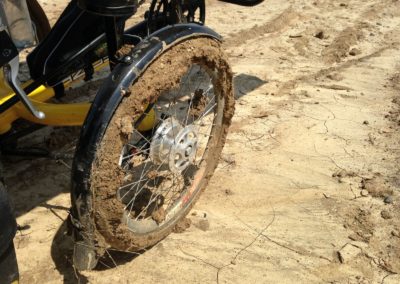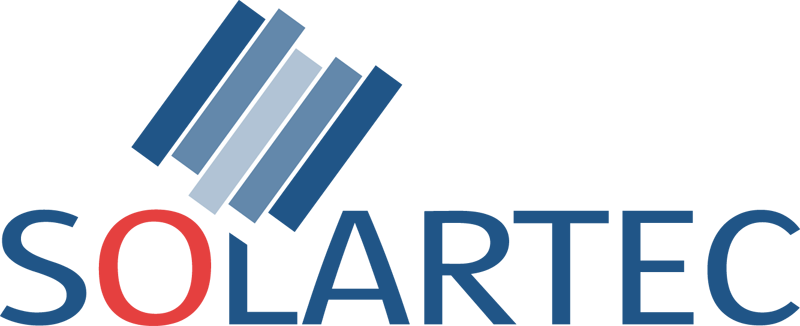

Km
Days / Dní
Countries / Zemí
Our solar trikes
We have built our solar electric trikes around the world known AZUB TRIcon 20 recumbent trike which was customized so it had no folding mechanism and had a custom built front boom and rear rack so the roof with solar panels could be added to it. Otherwise the components were pretty standard with Shimano Alivio 3x8 speed components, Sturmey Archer 90mm drum brakes, Remerx rims etc. We built a special combination of chain rings for the crankset with 70 teeth biggest chain wheel and than 52 and 30 teeth. We did not used any front derailleur so our hands acted like front derailleurs. We did not need to change the front gears often. We mostly used the largest chain wheel because of the higher speeds and 20″ rear wheel. When the chain was on the smallest ring, the chain was touching the ground, of course. We had to use it only on the steepest sections and we did it like 4 times in total. If we would go once again for such a race we would not use trikes anymore. They are shaking too much side to side. It is difficult to find the right track for them and they are more complicated than bikes. Maybe the new full suspension recumbent trike AZUB Ti-FLY would work good, but we would most probably opt for something like the dual 20″ wheel recumbent AZUB MINI which Honza has used during other expeditions or the AZUB SIX. Or maybe the AZUB TWIN recumbent tandem with solar panels instead of the stoker 🙂
The solar roof and the trailer were both custom built. And openly spoken, they were kind of under-engineered. We had problems with them from the day 5 and all the next days were just one looooong fight to get them to Astana. The only day we did not need to do anything with them was the day after 48 compulsory hours spent in Tuapse, Russia. We spent there a full day repairing everything. We recommend riveting instead of welding for any construction.
Regarding the electric part of our electric trikes, we used Chinese stuff for the motor and the regulator. It was the Golden Motor. The firstly chosen BionX engine which we would prefer normally did not want to cooperate with our system of charging at that time, but it is better now, we guess. We also built our own battery packs which were exactly 1100Wh and 48V. We used custom built Genasun solar charge controllers to manage the power coming from solar panels. Those were also custom built by Solartec. They used so-called Reptile cells, which were kind of recycled solar cells from those damaged during production. We did some testing for them. They no longer have the research lab under their wings and there is the new company called Fill Factory existing for special projects. Regarding the solar panels, we made a mistake and laminated them to aluminum sandwich panels which did not ventilate properly or even cumulated the heat so we were losing a lot of efficiency. Using semi-flexible solar panels is correct, we think.
Naše tříkolky jsme postavili na osvědčeném základu ležaté tříkolky AZUB TRIcon 20, kterou jsme upravili tak, že neměla skládací mechanismus, ale zato dostala do výbavy na zakázku svařený přední šlapák a zadní nosič tak, aby na ně mohla být uchycena solární střecha. Většina komponentů však byla poměrně standardních. Použili jsme systém řazení Shimano Alivio s 3x8 převody, bubnové 90mm brzdy Sturmey Archer a ráfky od Remerxu. Speciální byly rozhodně kliky. Použili jsme největší 70 zubový převodník a pak 52 a 30 zubů. Neměli jsme namontovaný žádný přesmykač a rychlosti vepředu jsme překazovali růčo. Nebylo to však třeba dělat často, protože díky elektromotoru a malému 20″ zadnímu kolu jsme jezdili nejčastěji na největší placku. Když jsme měli zařazen nejmenší převodník, řetěz se nám samozřejmě válel po zemi. Tento převod jsme však používali jen jako vyprošťovák do těch největších kopců. Všehovšudy jsme jej použili asi čtyři krát. Kdybychom jeli na podobný závod znovu, rozhodně bychom znovu nestavěli tříkolky. Příliš se třepo ze strany do strany, je těžší pro ně najít dobrou stopu a také jsou komplikovanější než běžné kolo. Pravděpodobně bychom zvolili lehokolo AZUB MINI, se kterým Honza absolvoval mnohé své předešlé náročné cesty, nebo třeba AZUB SIX. Případně ležatý tandem AZUB TWIN, na kterém by místo háčka “seděly” solární panely a nebylo by tak třeba táhnout s sebou přívěs.
The solar roof and the trailer were both custom built. And openly spoken, they were kind of under-engineered. We had problems with them from the day 5 and all the next days were just one looooong fight to get them to Astana. The only day we did not need to do anything with them was the day after 48 compulsory hours spent in Tuapse, Russia. We spent there a full day repairing everything. We recommend riveting instead of welding for any construction.
Regarding the electric part of our electric trikes, we used Chinese stuff for the motor and the regulator. It was the Golden Motor. The firstly chosen BionX engine which we would prefer normally did not want to cooperate with our system of charging at that time, but it is better now, we guess. We also built our own battery packs which were exactly 1100Wh and 48V. We used custom built Genasun solar charge controllers to manage the power coming from solar panels. Those were also custom built by Solartec. They used so-called Reptile cells, which were kind of recycled solar cells from those damaged during production. We did some testing for them. They no longer have the research lab under their wings and there is the new company called Fill Factory existing for special projects. Regarding the solar panels, we made a mistake and laminated them to aluminum sandwich panels which did not ventilate properly or even cumulated the heat so we were losing a lot of efficiency. Using semi-flexible solar panels is correct, we think.
Krátký koment, který jsem přidal do diskuze na nakole.cz:
Po dlouhé době jsem narazil na tuto diskuzi.
My jsme teda během Sun Tripu 2013 měli baterie zároveň nabíjeny z panelu jak na tříkolce, tak na vozíku. Dohromady to bylo kolem 520Wp. Zároveň jsme nabíjeli i jeli. Vše jen s jednou baterií o kapacitě cca 1100Wh. Myslím to byla Li-Ion.
K tomu jsme používali dva regulátory, které jsme si nechali vyrobit na zakázku v https://genasun.com, ale dají se tam pořídit i nějaké běžné. Je totiž pravdou, že běžně seženete regulátory zhruba do 200W a pak až na několik tisíc wattů, které už jsou těžké jak sviňa. Toto byla malá krabička za cca 6000 Kč. Používali jsme ke každému panelu jednu. Dají se snad sehnat i v Evropě od http://www.declic-eco.fr.
Dokázali jsme tak ujet až 300 km za den na plně naložených dost těžkých tříkolkách.
Motor Watts
Wp of solar panels per trike & trailer
Max speed km/h

Team

Honza Galla
the bike guy
Long time avid cycle traveller who have done many tours on recumbent bikes, folding bikes, recumbent tandems and upright tandems as well. Honza works in AZUB BIKE as a sales and marketing manager. They produce recumbent bikes and trikes. He was the one who came with the idea of participating in The Sun Trip. His role in the team was to take care about the bikes, trailers and all the other outdoor equipment. He also though he would inform the world about the progress via articles on the web page but that was soon overtaken by Karel. Honza is happy father of two. Julie and Janek.
Dlouholetý nadšený cykloturista, který absolvoval mnoho dlouhých cest na lehokolech, skládacích kolech, ležatých i vzpřímených tandemech. Honza pracuje ve společnosti AZUB BIKE s.r.o. jako sales and marketing manager. Právě on přišel s nápadem účastnit se závodu solárních kol The Sun Trip. Jeho rolí v týmu bylo především starat se o pojizdnost kol, vozíků a funkci dalšího outdoorového vybavení. Také předpokládal, že bude informovat o postupu prostřednictvím našeho webu, ale tuto roli záhy převzal Karel. Honza je šťastným otcem dvou dětí Julie a Janka.

Karel Šebela
the electric guy
Not really a sportsman. Not really a cyclist. But definetely a guy brave enough to say yes to an 8000 km long adventure to the east although he always has travelled to the west. Owner of few businesses and also a builder of an experimental ecological house called Czech Earthship. His role was to take care about all the electric and electronic on both bikes and at the end also writing updates from the trip. Happy father of two Bára and Patrik.
Rozhodně ne sportovec. Rozhodně ne cyklista. Zcela určitě však chalp dost odvážný na to, aby se vydal na 8000 km dlouhou cestu na východ, i když před tím jezdil vždycky jen na západ. Podnikatel a stavitel experimentálního ekologického domu zvaného zeměloď, neboli Czech Earthship. Jeho rolí v týmu bylo starat se o veškerou elektriku a elektroniku a nakonec i pravidleně informovat o našem postupu na webu. Šťastný otec Báry a Patrika.
Photo gallery
Video gallery

Pouť českého týmu z Francie do Kazachstánu
Dne 31.7.2013 ve 20:35 místního času dorazil Czech Solar Team ve složení Karel Šebela a Honza Galla do cíle závodu solárních kol v kazašském hlavním městě Astaně. Start se konal 15. června ve francouzském Chambéry a dvěma českým účastníkům trvalo 46 dní, 10 hodin a 35 minut dostat se do Astany, což stačilo na celkové čtvrté místo z 28 startujících. V cíli se objevili jako první dvoučlenný tým a na své pouti urazili vzdálenost 7804 km.
The Sun Trip, jak se závod nazývá, se jel v roce 2013 poprvé a byl organizován Francouzem Florianem Baillym, který v roce 2010 dojel na solárním kole z Francie do Japonska a jehož cesta je všeobecně považována za první solárně-expedičně-cyklistickou vůbec. Závod se jel expedičním charakterem, tedy bez jakýchkoliv podpůrných aut a také trasu si účastníci volili sami dle svých možností a aktuální situace. Jediným kontrolním bodem na trase bylo ruské město Soči na břehu Černého moře, kde se v roce 2014 konala zimní Olympiáda. Závod měl za cíl propagovat obnovitelné zdroje energie využitelné v dopravě.
Český tým vsadil na dvě české ležaté tříkolky AZUB TRIcon 20 a doplnil je o solární panely firmy Solartec, které byly umístěny nad hlavou jezdců a na vozících. Celková délka soupravy činila 5,5 metru, hmotnost plně naloženého kola (bez jezdce) s přívěsem byla cca 100 kilogramů a panely o celkovém výkonu přes 550Wp měly plochu 4 metry čtvereční. Motor byl umístěn v zadním kole a dokázal rozpohybovat celou soupravu až na maximálních 35 km/h. Česká koncepce tak byla v podstatě extrémem, který povolovaly pravidla. Tedy využití maximální možné velikosti stroje a potažmo solárních panelů a maximální kapacity baterií. “Nejsme žádní sportovci. Spíše jsme se zvedli z kanceláře a jeli si splnit svůj sen. Museli jsme vsadit na sílu Slunce spíše než na sílu nohou” říkl Karel Šebela o své strategii. Ta nám dávala výhodu když opravdu svítilo, ale brzdila je, když bylo dlouho pod mrakem, nebo foukal silný protivítr. “Letos počasí tomuto závodu moc nepřálo a dokonce nám vydatně pršelo i v Kazachstánu, o kterém se tvrdí, že je v létě téměř bez deště” dodal Karel. Byli jsme tak schopni jezdit za dobrého počasí 200 až 300 km denně, ale ve dnech bez Slunce ujetá vzdálenost klesala pod 100 km.
Vybrali jsme si tzv. severní cestu, tedy Ukrajinou kolem Černého moře, zatímco jiní účastníci volili trasu jihem přes Turecko. Projeli jsme tak 10 zemí a to Francii, Itálii, Slovinsko, Chorvatsko, Srbsko, Rumunsko, Moldávii, Ukrajinu, Rusko a Kazachstán, přičemž v poslední z nich ujeli více než třetinu z celkové vzdálenosti.
Od začátku jsme se drželi na předních pozicích, ale záhy v Rumunsku Honzu kousl pes, bylo třeba dostat injekce proti vzteklině, a ztratili jsme proto dva dny. K tomu se přidaly deště na Ukrajině a čelo závodu v podobě lídra Belgičana Rafa Van Hulle a Francouze Jörge Molity, jsme v podstatě ztratili. Pohybovali jsme se pak svou standardní rychlostí kolem 200 km za den a udržovali si třetí místo. Projeli ukrajinský Krym, ruské černomořské pobřeží a přes boční hřeben Kavkazu se přehoupli do vnitrozemí, abychom zamířili ke Kaspickému moři.
Za Astrachaní jsme překročili hranice do Kazachstánu a museli se rozhodnout, zda zvolit jistotu a asfaltovou silnici severem přes Uralsk, a nebo o tři sta kilometrů kratší cestu přímo na město Aktobe, která však znamenala velmi náročných 250 kilometrů po silnicích bez asfaltu v místech s minimálním osídlením, kde je třeba s sebou mít dostatek vody i zásob alespoň na dva dny. Touha po dalším dobrodružství zvítězila a po výrazném doplnění zásob jsme se vydali jižní cestou. Bohužel však došlo k nehodě, a při vyhýbání se kamionu, Honza doslova zmizel v jednom z ohromných kazašských výmolů, a porušil část konstrukce svého stroje. To znamenalo návrat autem do Atyrau a opravu, což zabralo dva dny, a protože svaření v místním servisu vypadalo více než bídně, bylo třeba se vydat po severní cestě přes Uralsk a jet už na jistotu. To už jsme byli na čtvrtém místě se ztrátou téměř 400 km na třetího závodníka. Během následujících dní jsme se ještě snažili ztrátu stáhnout a dokázali se dostat až na rozdíl pouhých 100 km, ale v posledním týdnu před Astanou se počasí výrazně zhoršilo, pršelo a foukal protivítr, a proto bylo výsledkem právě ono čtvrté místo, které pro nás i tak znamenalo obrovský úspěch, neb hlavním cílem ‘bylo závod především dokončit.
„Přemýšleli jsme nad tím, co bychom udělali jinak a proč byl Raf rychlejší než my. Měli jsme jinou koncepci a větší odpor vzduchu. Brali jsme to více jako výlet a měli hodně náhradních dílů včetně jednoho motoru. Díky třem stopám jsme vymetli každou díru. A pak těch několik dní zpoždění díky psovi a nehodě. To se nedalo moc ovlivnit“ poznamenává Honza k účasti v závodu a k výsledku, a dodává: „V každém případě jsme nadšeni z toho, že se nám podařilo dojet až do Astany. Tu a tam to vypadalo dost zle“.
The Mission of the Czech Team from France to Kazakhstan
On 31 July, 2013, at 8:35 in the evening (local time), the Czech Solar Team consisting of Karel Šebela and Honza Galla arrived at the finishing line of the solar bicycle race in the Kazakh capital of Astana. The race started on 15 June in Chambery, France, and it took the two Czech participants 46 days, 10 hours and 35 minutes to reach Astana, thereby securing the overall 4th place out of 28. Karel and Honza were the first two-man team to arrive at the finishing line, having covered a distance of 7804 km.
The Sun Trip, as this race is called, took place for the first time in 2013 and was organized by Florian Bailly, a Frenchman who travelled on a solar powered bike from France to Japan in 2013 and whose journey is generally considered the first solar cycling expedition ever. The race had an expedition character, which means that participants travelled without any supporting vehicles and were able to choose whichever route they wanted according to their capabilities and current situation. The only control point on the route was the Russian city of Sochi on the Black Sea coast, where the 2014 Winter Olympics took place. The purpose of the race was to promote renewable energy sources usable in transportation.
The Czech team decided on a Czech recumbent trike, the AZUB Tricon 20, and solar panels from the company Solartec, which were fitted on each trike above the riders’ heads and also on the trailers. The total length of the whole setup was 5.5 meters, the fully loaded bike (without the rider) with the trailer weighed about 100 kilogrammes and the panels with a total power of over 550Wp covered 4 square metres. The motor in the rear wheel was able to get the whole thing up to the maximum 35 km/h. Basically, the Czech concept was the extreme of what the rules allowed, that is using the maximum possible size of the machine and the solar panels, and the maximum capacity of the battery. “We are no sport fanatics, we just thought we would get out of the office and fulfil our dream. We had to rely on the power of the sun rather than the strength of our legs” Karel Šebela explained their strategy. “Our legs could rest a bit when it was really sunny, but when it was overcast for a long time or when there was strong headwind, our legs had to work really hard. This year the weather was not very good to this race and we even experienced heavy rain in Kazakhstan, which is said to have almost no rain in summer,” says Karel. Therefore, we were able to cover about 200 to 300 kilometres a day in good weather, but when the sun was hiding, our daily mileage fell below 100 km.
We chose the so called northern route, through Ukraine and around the Black Sea, while other participants opted for the southern route, through Turkey. Overall, we travelled through 10 countries, namely France, Italy, Slovenia, Croatia, Serbia, Romania, Moldova, Ukraine, Russia and Kazakhstan, with more than a third of the total journey spent in the last of them.
From the very beginning we stayed in the front positions but soon after, in Romania, Honza was bitten by a dog. We had to get him the necessary shots against rabies and therefore we lost two days. Then there was heavy rain in Ukraine and we lost on the leading riders, the Belgian Raf Van Hulle and French Jorge Moita. The following days our standard speed was 200 km per day and we maintained the third place. Riding through the Ukrainian Crimea, the Russian Black Sea coast and across the lateral ridge of the Caucasus we rode inland, heading to the Caspian Sea.
Upon leaving Astrakhan we crossed the border into Kazakhstan and had to decide whether to go for the safe option and take the asphalt road north through Uralsk, or choose a route shorter by three hundred kilometres, one leading directly to the city of Aktobe. However, that meant doing a gruelling 250 km on unsurfaced roads through places with minimal population where you need to carry have enough water and supplies for at least two days. The desire for yet more adventure prevailed and after we substantially replenished our supplies, we set off due south. Unfortunately, we had an accident when Honza literally disappeared in one of the massive Kazakh potholes while avoiding a truck and damaged a part of his bike. That meant going back to Atyrau by car and having the bike repaired. The whole interlude took two days and because the welding job of the local service place looked more than poor, we had no choice but to carry on with the journey by the northern route through Uralsk, to be on the safe side. At that point we were in the fourth place with the loss of almost 400 km on the third cyclist. Over the following days we tried to make up for the loss and managed to shrink the gap to only 100 km, but in the last week before Astana the weather deteriorated significantly with a lot of rain and strong headwind. So in the end we did finish in the fourth place which was a huge success anyway, because the main goal was to actually finish the race.
“We thought about what we could have done differently and why Raf was faster than us. We adopted a different concept and had a greater air resistance. We took it more as a trip and carried a lot of spare parts, including one motor. Having three wheels we also caught each and every hole and then there was the delay because of the dog and the accident. There was not much we could have done about that” said Honza about their participation in the race and the result, adding: “In any case, we are really pleased that we actually managed to reach Astana at all. Now and again things looked pretty hairy.”


